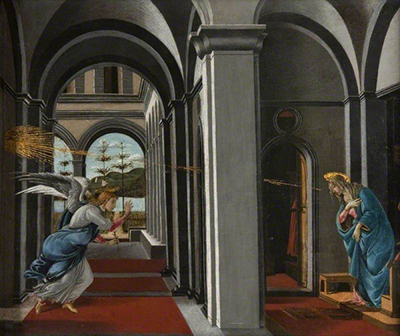Sandro Botticelli painted this version of The Annunciation in 1490-95, at around the same time that he created many other depictions of this famous topic
Whilst this fresco does not have the fame or academic respect of his earlier artwork, Cestello Annunciation, it still teaches us more about this significant artist and the drives and influences that he had as an artist.
There is relatively little documentation and research available on this painting as compared to his others of the same theme, but the original remains on display in Glasgow, Scotland. There have been some discussion over whether Botticelli made use of assistants in this item, and this was common throughout his career so may well have been the case.
This painting was produced using oil, tempera and gold leaf on walnut panel. This process is highly typical of Botticelli, throughout his career. During this period of the Renaissance there were not many options available to artists in terms of different mediums. Annunciation Annunciation (1485) Cestello Annunciation
The Vancouver Art Gallery hosted a fine series of Renaissance in 2015, with an exhibition titled Of Heaven and Earth: 500 Years of Italian Painting from Glasgow Museums. With in that, this version of The Annunciation speadheaded much of the press surrounding its launch and was presented prominently within the display.
This decision was perhaps down to the name of Botticelli being likely to sell the exhibition rather than the qualities of this particular artwork. He was not the only significant name to appear, however, being joined by the likes of Giovanni Bellini, Titian, the Cavaliere d’Arpino (Giuseppe Cesari), Francesco Guardi, Domenichino and Salvator Rosa.




